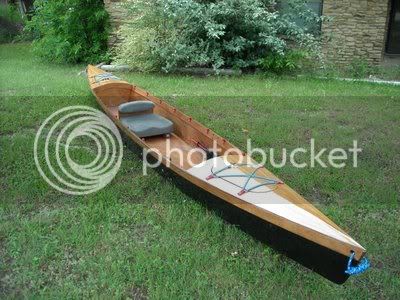What I'm saying is that to compare two things, you have to remove as many variables as possible. Adding effects of current, wind, individual paddler, etc. muddies up the situation so much that you are no longer able to separate fly specks from the pepper, nor are the results reliable.
The examples of various shaped cross-sections of boat bottoms, all the same length is a fer instance. While there was an arbitrary waterline presented, what was omitted is the AREA described by each, individual cross-section under that waterline. Each cross section, though having the same length of line for a bottom, would hold a different volume.
What that means is that each one, if loaded with the same weight, would no longer have that same, arbitrary waterline. Only with varying loads would that imaginary waterline remain a constant. The cylindrical cross-section will provide more volume, therefore carry more weight. The more closely a hull shape approximates cylindrical, the more load bearing capacity it will have with minimum wetted surface.
A perfectly cylindrical cross-section is impractical for real world use, so designers alter and tweek it some. That's where individual designs and handling characteristics begin to vary quite widely. A semi-round bottomed with pointy ends will handle considerably different than a boxy, flat-bottomed boat. I guess, you could even use a square mortar box (like what is used to hand mix mortar and concrete in) as a boat, but I'd rather not.
I recommend that you have private email-type conversations with Matt, and listen carefully to what he says.
The examples of various shaped cross-sections of boat bottoms, all the same length is a fer instance. While there was an arbitrary waterline presented, what was omitted is the AREA described by each, individual cross-section under that waterline. Each cross section, though having the same length of line for a bottom, would hold a different volume.
What that means is that each one, if loaded with the same weight, would no longer have that same, arbitrary waterline. Only with varying loads would that imaginary waterline remain a constant. The cylindrical cross-section will provide more volume, therefore carry more weight. The more closely a hull shape approximates cylindrical, the more load bearing capacity it will have with minimum wetted surface.
A perfectly cylindrical cross-section is impractical for real world use, so designers alter and tweek it some. That's where individual designs and handling characteristics begin to vary quite widely. A semi-round bottomed with pointy ends will handle considerably different than a boxy, flat-bottomed boat. I guess, you could even use a square mortar box (like what is used to hand mix mortar and concrete in) as a boat, but I'd rather not.
I recommend that you have private email-type conversations with Matt, and listen carefully to what he says.


